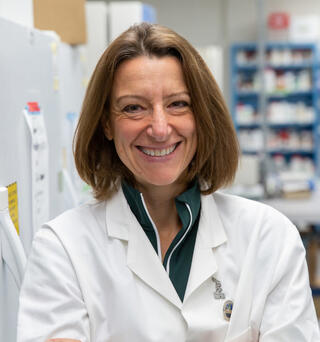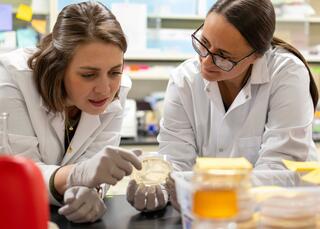
Three years after joining the Great Lakes Bioenergy Research Center, Michigan State University microbiologist Sarah Lebeis has been tapped to guide the center’s scientific research.
Lebeis, an associate professor of plant, soil, and microbial sciences, studies the interactions between plants and the communities of microbes that live in and around their roots. The goal is to learn how both affect which microbes are part of these tiny ecosystems, knowledge that could lead to more productive and resilient crops.
Her research aims to bridge the gap between controlled experiments and the complexity of natural systems — in other words, why does something work in the lab but not in nature?

In one recent study, her lab showed how plants use a type of sugar called myo-inositol to recruit certain microbes to colonize their roots. Lebeis also investigates how some root microbes survive in spite of antibiotic compounds that plants produce to protect themselves and how microbes interact with one another within the microbiome.
“I’m a very glass-half-full microbe kind of girl,” Lebeis said. “So we think about how do microbes help plants in stressful conditions?”
Understanding these mechanisms can help scientists develop better products to improve food productivity and bioenergy production. For example, it’s well known that certain microbes help plants, but microbial-based products aren’t always effective when applied in the field.
“When you try to change the microbiome, it often doesn’t work,” Lebeis said. “A lot of what my lab is trying to figure out is why doesn’t it work? Why is the benefit lost?”
The challenge is understanding such complex systems.
“We can characterize how individual microbes interact with individual plants, knowing that that’s not what happens in nature,” Lebeis said. “Then ... we build up complexity.”
Lebeis says GLBRC’s interdisciplinary structure is ideally suited to investigating these topics. She is especially interested in using machine learning — a type of artificial intelligence — to analyze the extremely complex plant-microbe interactions and to connect with scientists working on plant deconstruction.
Lebeis, who currently leads the GLBRC’s bioenergy crop productivity and microbiome team, will take over Dec. 1 as one of the center’s science directors.

GLBRC Director Tim Donohue said Lebeis is well positioned to move the center forward, noting her internationally recognized expertise and experience leading a GLBRC research team and representing the center in ongoing collaborations with the three other Department of Energy Bioenergy Research Centers.
“She has expertise in how plants, microbes, and soil interact to promote energy crop resilience,” Donohue said. “I and others in GLBRC leadership have seen the breadth of knowledge, energy, and interpersonal skills needed for success as a science director.”
Lebeis will take over for Federica Brandizzi, serving alongside current science director Robert Landick, a professor of biochemistry at the University of Wisconsin–Madison.
Brandizzi, who served as science director for the past four years, is stepping down to lead the MSU-DOE Plant Research Laboratory.
“Federica has done an amazing job. I don’t even see it as filling shoes, because it’s not possible,” Lebeis said. “I’m super excited for her next role. I’m equally excited that she’s staying on the management team and will continue to work with us.”

Though relatively new to GLBRC, Lebeis has years of experience working with multiple Department of Energy bioenergy research initiatives.
Lebeis grew up in a Detroit suburb and studied biology at MSU before earning a PhD in microbiology and molecular genetics from Emory University in Atlanta.
As a postdoctoral researcher at the University of North Carolina in 2010, Lebeis worked on a project to sequence the DNA of bacteria from root systems of more than 600 plants in partnership with the Joint Genome Institute, a DOE user facility at the Lawrence Berkeley National Laboratory. The study resulted in a 2012 paper in Nature and a subsequent paper in Science.
“That was the first time we worked with JGI, which was an incredible experience,” Lebeis said. “I was hooked.”
When she landed a faculty position at the University of Tennessee, Lebeis said her first grant proposal was to a program run by JGI and the Environmental Molecular Sciences Laboratory for a duckweed microbiome study. That program gave her access to those labs as well as Oak Ridge National Laboratory and the Center for Bioenergy Innovation.

Lebeis returned to MSU in 2020 and was invited to join GLBRC in 2022. The following year she took over leadership of the bioenergy crop productivity and microbiome team the following year.
Lebeis saw it as an opportunity to cross-validate her research on the model plant arabidopsis with bioenergy plants like switchgrass, sorghum, and poplar.
“One of the reasons I moved to Michigan State was to get outside of my sphere and see how the research I do fits in with all of these other fields and applications,” she said. “That idea of moving from basic to applied ... is really exciting about GLBRC.”
While her administrative duties will cut into her own research time, Lebeis welcomes the opportunity to foster collaborations that span not just labs but teams.
“I’m excited to expand the conversations and the connections that I make between groups,” Lebeis said. “If you look at the full spectrum of what GLBRC does, you can get to really exciting and interesting things that are happening in nature.”